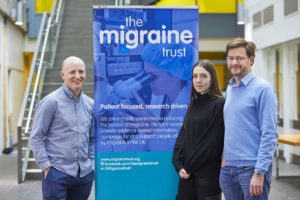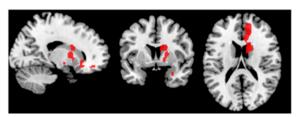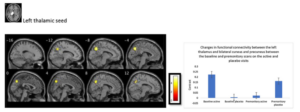Research we have funded
Read about some of the projects and researchers we have supported
For almost 60 years The Migraine Trust has been investing in research enabling internationally renowned experts to conduct projects through research grants and Research Fellowships. We also seek to encourage the next generation of experts in the form of PhD Studentships and Fellowships.
Over the years we have funded a wide range of projects addressing current themes and ideas in migraine understanding and treatment.
This includes:
- Research that identified pain nerves in the head as being crucial targets for migraine treatment, paving the way for triptans to move from a blood vessel to a brain target
- Studies that explored and promoted the development of ditans and gepants, new classes of acute migraine treatment
- Experimental work to understand the role of calcitonin gene-related peptide (CGRP) in migraine and cluster headache, paving the way for the development of CGRP pathway targeted preventive treatments
- Human brain imaging studies to understand and characterise the pathways crucial to the disorder
- Supported basic scientists and clinical scientists with career awards for their research
- Three times more women will experience migraine than men and hormonal changes can be a common trigger. We have funded a number of studies on the impact of hormones and migraine.
In 2019 we funded a PhD studentship for a project led by Dr Jan Hoffmann and Dr Philip Holland at the Institute of Psychiatry, Psychology and Neuroscience, King’s College London. Neuroscientist Hannah Creeney was awarded a studentship to work on the project looking at the neurophysiological role of amylin in migraine.
Amylin is a neuropeptide that is known to have similar mechanisms to calcitonin gene-related peptide (CGRP), a neuropeptide that is released during migraine attacks and can increase the activation of the nerves that relay headache and facial pain signals to the brain. Amylin and CGRP bind to each other’s receptor and this research was looking at whether amylin’s actions on these receptors are relevant for migraine. The research aimed to determine if an increased understanding of amylin could lead to a new treatment for migraine.

Meet some of the researchers and scientists we have supported:
Dr Shazia Afridi lead ground breaking research into the shape of the brain during a migraine attack and she set up the headache clinic at Guy’s and St. Thomas’s hospital in London where she now practices as one of the UK’s leading consultant neurologists.
Shazia won a PhD Studentship from The Migraine Trust over fifteen years ago. Shazia said: “Funding from The Migraine Trust is incredibly important. It has significantly contributed to our understanding of migraine. It is unique in that it is a patient-focussed organisation which champions research. We have come a long way, but there is still so much more we need to understand about migraine.”
Dr Karsan is Clinical Research Fellow at the Wolfson Centre for Age Related Diseases
“With the support of The Migraine Trust, we were able to conduct an imaging study at King’s College London using two different types of MRI scans. We scanned the brains of patients with migraine four times after triggering an attack using an intravenous infusion. We performed the scans on arrival to the research facility in the absence of any symptoms, during premonitory symptoms, or the prodrome, when patients experience symptoms and can feel a headache will come on soon, during migraine headache, and after headache resolution with treatment. The findings were exciting, and contributed to the scientific literature about the role of several brain areas and connections in migraine, including in the initiation of the attack before headache. We are hopeful that this work will help further understanding about how migraine starts in the brain and help to advance treatment development.
The work would not have been possible without The Migraine Trust. From funding, to how we designed the study with patients in mind and communicated with patients about what they would be happy to engage with from a research perspective, and being the largest source of patient recruitment. The work has been published in two separate papers in the journal Headache in 2020 and 2023.”
One type of MRI looked at differences in brain blood flow during migraine compared to baseline. The red areas show areas of increased blood flow, and therefore increased brain activity in migraine – Karsan et al. Regional cerebral perfusion during the premonitory phase of triggered migraine: A double‐blind randomized placebo‐controlled functional imaging study using pseudo‐continuous arterial spin labeling. Headache 2023; 63: 771-787

Another MRI technique looked at differences in brain connections during migraine compared to baseline. The yellow areas show areas of different connectivity with the area above the image (thalamus in the top image and pons in the bottom image) in migraine – Karsan et al. Alterations in Functional Connectivity During Different Phases of the Triggered Migraine Attack. Headache 2020; 60(7):1244-1258

 Dr Joseph Lloyd completed his The Migraine Trust PhD Studentship in 2021 investigating sTMS (single pulse transcranial magnetic stimulation) mechanisms of action in the Headache Research laboratory at King’s College London. His research focused on migraine patients prescribed sTMS at the Headache Centre at Guy’s and St Thomas’ NHS Foundation Trust. sTMS is a portable device that can be carried around and used to both treat the headache as the attacks are happening and in reducing the number of migraine days per month as a preventive treatment.
Dr Joseph Lloyd completed his The Migraine Trust PhD Studentship in 2021 investigating sTMS (single pulse transcranial magnetic stimulation) mechanisms of action in the Headache Research laboratory at King’s College London. His research focused on migraine patients prescribed sTMS at the Headache Centre at Guy’s and St Thomas’ NHS Foundation Trust. sTMS is a portable device that can be carried around and used to both treat the headache as the attacks are happening and in reducing the number of migraine days per month as a preventive treatment.
The research showed how effective sTMS treatment is in reducing migraine days in a real-world population of difficult to treat patients. Following his PhD, Joseph continues to research headache disorders and is currently investigating the NF-kB pathway in the hypothalamus as it relates to Cluster Headache.
 Anna Andreou from Kings College London and Headache Centre, Guy’s and St Thomas’ NHS Foundation Trust
Anna Andreou from Kings College London and Headache Centre, Guy’s and St Thomas’ NHS Foundation Trust
“The Migraine Trust helped me to establish one of the world’s leading headache research labs and the first in the UK during a period no academic institution was undertaking migraine research. I started my career as a PhD student in Migraine and Neurological Sciences funded by The Migraine Trust, supplemented by a studentship I had received from the Cypriot Government. In my PhD I investigated the role of a glutamate receptor, named kainate receptor, as a potential therapeutic target for migraine treatments.
Following my PhD I moved to the University of California, San Francisco were I continued to work in the field of migraine research with my mentor Prof Peter Goadsby. At the time I returned back to UK however, there wasn’t a research lab in migraine or headache across the whole of the UK so I worked in the stroke field for a while until I was awarded a junior fellowship from The Migraine Trust a few years later. The Migraine Trust junior fellowship was an important career step as it helped me to start my independent line of work into the pathophysiology of migraine and the development of novel therapies. I managed to extend my support from the charity into a senior non-restricted fellowship which allowed me to expand my research team by investing into the development of a PhD student, Joe Lloyd. Joe trained in my lab and is currently a successful post-doctoral researcher in the field of migraine. Joe’s PhD focused on the mechanisms of action of single pulse transcranial magnetic stimulation in migraine, as well as, on its efficacy in migraine patients, as at the same time we succeeded in receiving NHS funding for the sTMS treatment to become available for our migraine patients at the Headache Centre.
Today I’m director of Headache Research and senior lecturer at KCL and at the Headache Centre at Guy’s & St Thomas’ NHS Trust. I’m also a Trustee of the International Headache Society and chair of the Headache special interest group of the British Pain Society.
Without The Migraine Trust investment in keeping researchers like myself, continuing their research in migraine, this wouldn’t have been possible. It’s imperative we continue to invest in migraine research and careers as for too long it has been a much underfunded condition.”
Study name: Estrogen-dependent sensitization of trigeminal neuropeptide signalling: interplay of migraine and temporomandibular joint disorder
Carried out in 2024 at the Wolfson Centre for Age-Related Diseases Department at King’s College London Alejandro looked at the interplay of migraine and temporomandibular joint disorder, in particular why women experience higher coexistence of this disorders.
He also explored the influence of sex hormones in craniofacial sensory processing, as women are three times more likely to get migraine than men. This research aimed to determine which molecular mechanisms underlie this complex association, focusing on the influence of estrogen and its interaction with key neuropeptides involved in migraine.
“It is well-known that migraine is more prevalent and disabling in women, however, most of the preclinical research still focuses on males. This fellowship will allow me to research migraine female-specific mechanisms and will hopefully pave the way to new therapies. I am very grateful with The Migraine Trust for funding and recognising the translational potential of this research.”
Study name: Kisspeptin as a sexually dimorphic novel therapeutic target for migraine
Carried out at the Headache Group, Wolfson Centre for Age-Related Diseases, Kings College, London in 2024.
Her research explored the role of kisspeptin as a sexually dimorphic novel therapeutic target for migraine.
“Migraine is a predominately female disorder, despite this, research does not often focus on this or take into consideration the female hormonal cycle, reducing its real-world validity. This fellowship will allow me to investigate the basis behind this gender-gap in migraine, which will lead to new knowledge of the underlying sex differences, the characterisation of novel analgesic pathways, and the optimisation of current antimigraine therapies. I am extremely grateful with The Migraine Trust for this opportunity.”


